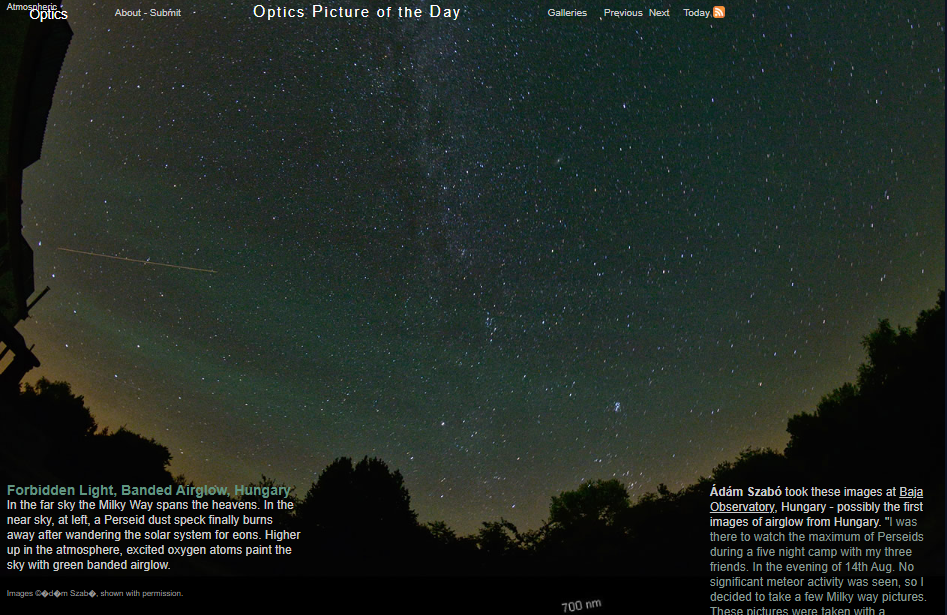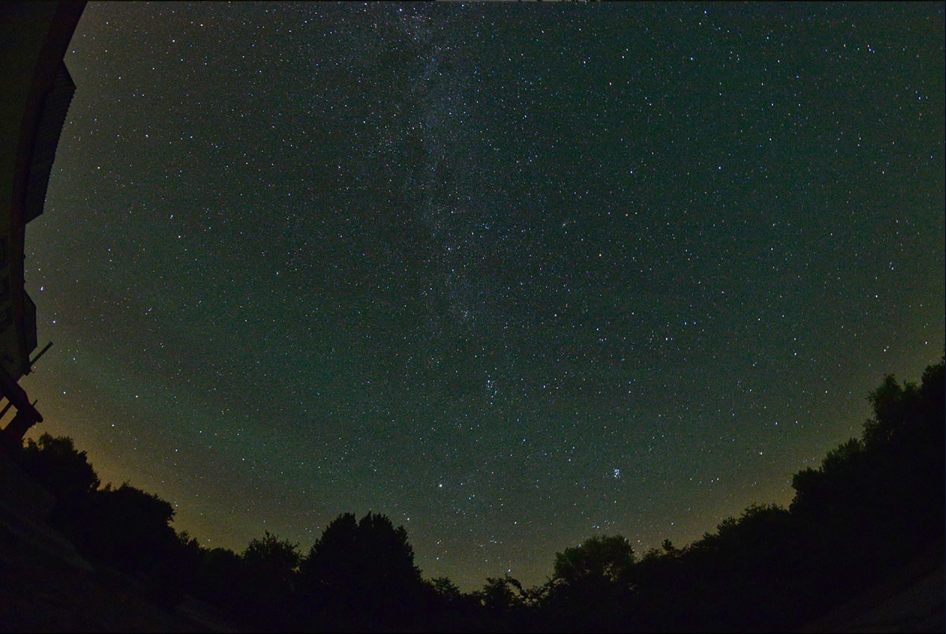OPOD - Forbidden Radiation - Hungarian Airglow
OPOD - Forbidden Radiation: Exploring the Enigmatic Hungarian Airglow
The beauty of the night sky is a constant source of wonder and fascination for stargazers and astrophotographers alike. Among the celestial wonders that adorn our atmosphere, there exists a mesmerizing phenomenon known as airglow. Recently, Ádám Szabó captured a series of breathtaking images of airglow at the Baja Observatory in Hungary, potentially the first of their kind from the region. In this article, we delve into the captivating world of airglow and explore the peculiarities of Hungarian airglow as observed by Szabó.
Unveiling the Spectacle: Ádám Szabó's Journey
Ádám Szabó embarked on a five-night camp at the Baja Observatory with his three friends, aiming to witness the peak of the Perseid meteor shower. While meteor activity remained relatively low that evening, Szabó's attention was captivated by an intriguing observation. He noticed variations in the background colors of his photographs, all taken with the same white balance setting. Curiosity piqued, he realized that what he was capturing was none other than airglow. Determined to document this ethereal phenomenon in finer detail, he adjusted his camera settings and successfully immortalized the elusive airglow bands.
The Mystery of Forbidden Light
One of the most fascinating aspects of airglow is its association with "forbidden" radiation. This intriguing term refers to the green light emitted by excited oxygen atoms in Earth's thermosphere, induced by the sun's far ultraviolet light. These atoms retain their energy for an astonishingly long time, measured in seconds—a duration that may seem inconceivable to us humans. Quantum theory unravels the enigma behind this phenomenon, revealing that atoms possess only discrete and fixed energies. However, the mathematics of quantum theory also presents "selection rules" dictating how excited states can decay and emit light. Airglow transitions, intriguingly, defy these rules, resulting in prolonged decay times. While seemingly unconventional, these transitions find their footing within higher order radiation theories.
The Thermosphere's Crucial Role
Airglow transitions predominantly occur in the near vacuum of the thermosphere, located at altitudes between 90 and 100 kilometers. At lower altitudes and higher pressures, collisions with other atoms and molecules deactivate the excited oxygen atoms, preventing airglow from manifesting. The delicate balance between sufficient concentration to produce significant light and collisional de-excitation defines the narrow altitude range where green airglow thrives, observable even from space.
The Influence of Density Waves
The manifestation of airglow is not solely dictated by altitude but also influenced by density waves originating from lower atmospheric layers. These gravity waves give rise to the distinctive banding observed in airglow phenomena. These bands create a captivating visual spectacle, enhancing the allure of airglow photography.
Unveiling the Elusive Airglow
Airglow is notoriously elusive, requiring pristine conditions to be observed visually. A dark sky devoid of moonlight and light pollution is crucial to witness this ethereal phenomenon firsthand. However, the camera lens unveils a hidden world, often revealing airglow more frequently than expected. Astute photographers, like Ádám Szabó, have the unique ability to capture the enchantment of airglow and share it with the world.
In conclusion, the Hungarian airglow witnessed and documented by Ádám Szabó adds a new dimension to our understanding of this captivating atmospheric optics phenomenon. The forbidden radiation emitted by excited oxygen atoms in the thermosphere, defying conventional selection rules, mesmerizes both scientists and enthusiasts alike. As we continue to explore the mysteries of our night sky, the allure of airglow beckons us to uncover its secrets and revel in its mesmerizing beauty.

Forbidden Light, Banded Airglow, Hungary
In the far sky the Milky Way spans the heavens. In the near sky, at left, a Perseid dust speck finally burns away after wandering the solar system for eons. Higher up in the atmosphere, excited oxygen atoms paint the sky with green banded airglow.
Images ©�d�m Szab�, shown with permission.
Ádám Szabó took these images at Baja Observatory, Hungary - possibly the first images of airglow from Hungary. "I was there to watch the maximum of Perseids during a five night camp with my three friends. In the evening of 14th Aug. No significant meteor activity was seen, so I decided to take a few Milky way pictures. These pictures were taken with a Samyang 8mm fisheye borrowed from the leader of the observatory, Tibor Heged�s. I noticed that pictures taken with the same white balance, showed differences in the sky background colors.. ..It came in my mind, that this must be airglow. Before that moment, I had taken pictures to freeze the stars with acceptable noise, but with the Milky way bright enough. Then I took pictures with lower ISO, because I saw that the airglow bands were moving relatively slowly - so this was my chance to record them with finer details." The airglow in the top image was seen by Ádám with his unaided eyes.
Green airglow is so-called �forbidden� radiation. The sun�s far ultraviolet light excites atoms and molecules high in Earth�s thermosphere. Excited oxygen atoms (direct or indirect products of the UV) can retain their energy for seconds. For an atom that is an unimaginable time span, something like the age of the Earth to us. Quantum theory predicts naturally and unasked out of its mathematics that atoms are allowed only discrete and fixed energies. More so, the maths produces �selection rules� that specify how an excited state can decay to a lower energy and emit light. Airglow transitions �disobey� these rules but the disobedience has a price, the excited states take an age to decay. The transitions are not unphysical, higher order radiation theories permit them.
Airglow transitions can only occur in the near vacuum of the thermosphere because, at lower altitudes and higher pressures, collisions with other atoms and molecules deactivate the excited oxygen first. There is a balance between sufficient concentration to produce significant light and collisional de-excitation. The result is that green airglow occurs in a narrow zone between 90 and 100 km high well seen from orbit.
The potential airglow is further influenced by density (gravity) waves from the lower air layers. These give the banding.
Airglow is usually very weak and needs a very dark sky free of moonlight and light pollution. It is hard to see visually but try some photographs, it will probably show up more often than is thought.



Note: this article has been automatically converted from the old site and may not appear as intended. You can find the original article here.
Reference Atmospheric Optics
If you use any of the definitions, information, or data presented on Atmospheric Optics, please copy the link or reference below to properly credit us as the reference source. Thank you!
-
<a href="https://atoptics.co.uk/blog/opod-forbidden-radiation-hungarian-airglow/">OPOD - Forbidden Radiation - Hungarian Airglow</a>
-
"OPOD - Forbidden Radiation - Hungarian Airglow". Atmospheric Optics. Accessed on November 25, 2024. https://atoptics.co.uk/blog/opod-forbidden-radiation-hungarian-airglow/.
-
"OPOD - Forbidden Radiation - Hungarian Airglow". Atmospheric Optics, https://atoptics.co.uk/blog/opod-forbidden-radiation-hungarian-airglow/. Accessed 25 November, 2024
-
OPOD - Forbidden Radiation - Hungarian Airglow. Atmospheric Optics. Retrieved from https://atoptics.co.uk/blog/opod-forbidden-radiation-hungarian-airglow/.